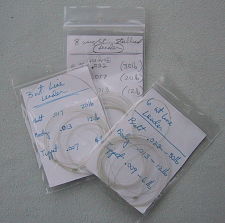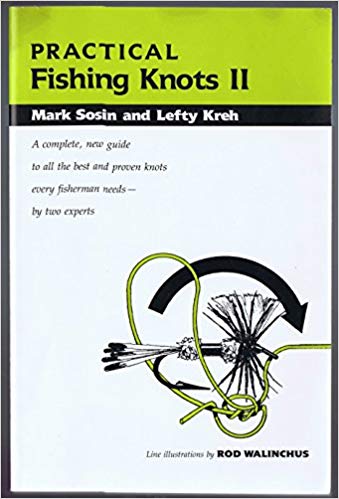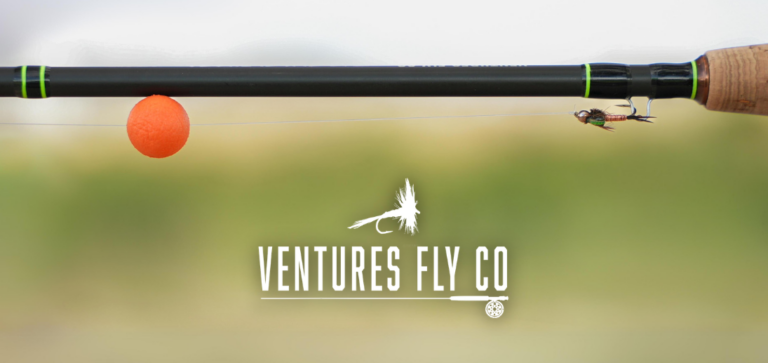This article was originally from FlyfishUSA website (page now defunct). Note: The brands mentioned in this article are sold by FlyfishUSA.
Fly Fishing Leaders, their construction and formulae for trout, steelhead and salmon.
Understanding Fly Leaders

Having an understanding of leader material and a practised knowledge of reliable fishing knots is as important to the angler as knowing how to cast. The leader and knots are the most fragile link between you and your fish. Frayed leader material, tangles, wind knots or a badly tied knot can release your trophy prematurely. The leader and knots must be checked constantly while fishing. Any problem areas should be repaired as soon as they are noticed. A properly designed fly leader enables the angler to deliver the fly with precision. The leader should provide a strong, nearly invisible link between the fly line and the fly.
The correctly designed fly leader transfers energy from the fly line to the fly in a predictable manner. Basic fly leader design incorporates a large diameter butt section, a gradually tapering midsection and a terminal tippet based on intended use. You will be a more successful angler with a working knowledge of leader design and application. With knowledge of proper knots, a store of the proper materials and a blue print to work from you can build your own fly leaders.
Accepted Principles of Leader Design
The leader butt attaches directly to the fly line and must be of a diameter similar to the end of the fly line to transfer energy from the fly line to the rest of the leader smoothly. The graduated mid-section transfers the energy from the butt section to the leader’s tippet. The butt and mid-section are designed as a delivery system for the tippet and fly. The tippet is the leader’s single most important component. The tippet size and type are determined by the fish and fishing conditions. Commercially made knotless tapered fly leaders are alright for many applications but for some situations it is better to make your own leaders by knotting together sections of monofilament and/or fluorocarbon.
Generally speaking leaders that are made for delivering a fly with authority are 60% butt, 20% mid-section and 20% tippet. Leaders that are designed for soft presentations or to combat drag have shorter butts and have longer mid-sections and tippets.
Building Your Own Tapered Leaders
A properly designed fly leader enables the angler to deliver the fly with precision. The leader should also provide a strong, nearly invisible link between the fly line and the fly. A correctly designed fly leader transfers energy from the fly line to the fly in a predictable manner. The leader butt attaches directly to the fly line and must be of a diameter and stiffness similar to the end of the fly line, so as to transfer energy from the fly line to the rest of the leader smoothly. The graduated mid-section transfers the energy from the butt section to the leader’s tippet. The butt and mid-section are designed as a delivery system for the tippet and fly.
The tippet is the leader’s single most important component. The tippet size and type are determined by the fish size and fishing conditions. You will be a more successful angler with a working knowledge of leader design and application. With knowledge of proper knots, a store of the proper materials and a blue print to work from, you can build your own fly leaders to any configuration needed to catch any fish.
Fly leaders can be very specific to the angling quarry and situation.

Pictured above is a very simple handmade leader specifically designed for catching steelhead with a sinking tip line. It is made from three sections of hard, abrasion resistant nylon such as Maxima.
The sections graduate from where the leader will be attached to the fly line down to where the fly will be attached. Each section is a different diameter and will serve a specific purpose. The formula for this leader is at right:
5’ Leader for
Steelhead
25 lb. Maxima = 15”
15 lb. Maxima = 15”
10 lb. Maxima = 30”
The length of this leader was chosen to give the fly maximum action and a practical amount of stealth to the angler. A five foot long leader will hide the fly line tip from most bottom hugging steelhead in water which has 4′-5′ visibility. The leader is short enough so that a heavy sinking tip line can hold a very lightweight fly close to the bottom. Normally a leader of this short length will turn over a heavily weighted fly for all but the poorest casters. So, you ask why not just tie on a piece of ten pound tippet material to the end of the fly line? A straight small diameter mono tied directly to the end of fly line could transfer enough energy to tum over the fly, but not as well as a graduated one.

You need a very strong attachment from the leader to the fly line. This is facilitated by attaching 15″ of large diameter monofilament to the tip of the fly line. Leaders of less than .020 diameter have proven unreliable when nail knotted to a fly line and fished for anadromous fish. The 30″ tippet section has been proven strong enough for most steelhead and pliable enough to allow medium size flies to move naturally in the water. The 15″ mid-section facilitates attachment of the tippet and butt sections by providing an intermediate diameter which will allow very strong knots to be tied easily.
This simple tapered leader is practical and inexpensive for the winter steelhead angler to make. You will need to carry several pre-tied leaders and a roll of tippet material while fishing. As leaders get longer their design can become more complex.
Most fly casters would agree that being able to throw narrow loops is an advantage when generating fly line speed for long accurate casts. In many cases having a leader at the end of the line that allows the tight loop energy to flow from the line to the fly and places the leader perfectly straight on the water is also an advantage, but not always. High velocity leaders are an advantage when casting flies that will be retrieved or fished under tension. However, a leader that dissipates energy and falls with slack may be more appropriate for dry fly fishing drag free. Such a leader may land on the water with gentle “S” curves that buffer drag. How a leader casts and lands can be dictated by design. How a leader turns over and straightens in the air is determined by casting presentation, leader taper and leader material. The last two factors are constructed into the leader itself.
A leader that is made from stiff material will transmit more energy than a leader made from soft pliable material. Large diameter material will hold more energy than small diameter material.
Generally speaking leaders that are made for delivering a fly with authority are 60% butt, 20% mid-section and 20% tippet. They can be made entirely from a stiff material such as Maxima Chameleon (Example #1). Leaders that are designed for softer presentations or to combat drag have shorter butts and have longer mid-sections and tippets. The butt and part of the mid-section is made from Maxima Chameleon, but part of the mid-section and the tippet are made from a softer material such as Umpqua tippet material (Example #2). For even softer presentations the butt of the leader is shortened and the tippet and mid-sections are lengthened (Example #3).

| 9'- 6X Trout Leader #1 | 9' - 6X Trout Leader #2 | 9' - 6X Trout Leader #3 | |||
|---|---|---|---|---|---|
| 25" = .020 = Maxima | 24" = .020 =Maxima | 20" = .020 = Maxima | |||
| 22" = .017 = Maxima | Butt | 20" = .017 = Maxima | Butt | 18" = .017 = Maxima | Butt |
| 17" = .015 = Maxima | 60% | 14" = .015 =Maxima | 54% | 14" = .015 = Maxima | 48% |
| 5.5" = .013 = Maxima | 8" = .013 = Maxima | 8" = .013 = Maxima | |||
| 5.5" = .010 = Maxima | Mid | 6" = .010 = Umpqua | Mid | 6" = .010 = Umpqua | Mid |
| 5.5" = .009 = Maxima | 20% | 6" = .008 = Umpqua | 24% | 6" = .008 = Umpqua | 26% |
| 5.5" = .007 = Maxima | 6" = .007 = Umpqua | 8" = .006 = Umpqua | |||
| 22" = .005 = Maxima | Tip | 24" = .005 = Umpqua | Tip | 28" = .005 = Umpqua | Tip |
| 20% | 22% | 26% |
The leader formulas given here are only presented as guide-lines. You could build leaders that are as little as 40% or even 30% butt. Be advised though that as the butt sections get shorter and the taper and tippet get longer, the leader will become harder to cast.
Knots

Understanding knot construction and application is critical to any fishing situation. Only with knowledge of knots can the angler manage his or her own gear. With an understanding of fly fishing knots you may construct your own leaders. Without knowledge of knots you can’t. For a better understanding of required knots we suggest you purchase of copy of: Practical Fishing Knots II by Lefty Kreh and Mark Sosin.
See also
Selecting Proper Materials
There are three basic types of monofilament available to the modem fly fisher.
Hard Type Monofilament & Fluorocarbon:
Hard Type is characterised by a hard abrasion resistant finish, stiff memory and low stretch. This type of monofilament is typically used for leader butts and abrasion resistant tippets.
Examples:
Maxima Chameleon
Maxima Clear
Frog Hair FC Fluorocarbon
Medium Type Monofilament & Fluorocarbon
Medium type is characterised by medium memory and low stretchability. Most commonly used in fresh water applications for graduations and tippets.
Examples:
Climax Fluorocarbon
Maxima Green
Rio Fluoroflex Plus
RioMax Plus
Umpgua
Soft Type Monofilament:
Soft Type is characterised by low memory, high shock absorption and pliability.
Examples:
Climax Tippet
Frog Hair Tippet
Rio PowerFlex
As much as we dislike saying so the given diameters on many brands of leaders cannot be trusted. You will need to buy a leader gauge and check the diameters yourself.
Leader Formulae
| Monofilament Diameter | ||||||||||||||
|---|---|---|---|---|---|---|---|---|---|---|---|---|---|---|
| Leader | 0X | 1X | 2X | 3X | 4X | 5X | 6X | 7X | ||||||
| 0.023 | 0.021 | 0.019 | 0.017 | 0.015 | 0.013 | 0.011 | 0.01 | 0.009 | 0.008 | 0.007 | 0.006 | 0.005 | 0.004 | |
| 6.5' 2X | 22" | 16" | 6" | 6" | 6" | 6" | 16" | |||||||
| 6.5' 3X | 22" | 16" | 6" | 6" | 6" | 16" | ||||||||
| 7' 3X | 22" | 16" | 6" | 6" | 6" | 6" | 16" | |||||||
| 7' 4X | 22" | 16" | 6" | 6" | 6" | 6" | 16" | |||||||
| 7.5' 2X | 24" | 10" | 10" | 10" | 6" | 6" | 18" | |||||||
| 7.5' 3X | 24" | 10" | 10" | 10" | 6" | 6" | 6" | 18" | ||||||
| 7.5' 4X | 24" | 10" | 10" | 10" | 6" | 6" | 6" | 18" | ||||||
| 9' 2X | 32" | 18" | 12" | 12" | 6" | 6" | 20" | |||||||
| 9' 3X | 32" | 18" | 12" | 6" | 6" | 6" | 6" | 20" | ||||||
| 9' 4X | 32" | 18" | 12" | 6" | 6" | 6" | 6" | 20" | ||||||
| 9' 5X | 30" | 12" | 12" | 10" | 6" | 6" | 6" | 6" | 20" | |||||
| 9' 6X | 30" | 12" | 12" | 8" | 8" | 8" | 6" | 6" | 20" | |||||
| 12' 5X | 36" | 24" | 18" | 10" | 8" | 8" | 6" | 6" | 28" | |||||
| 12' 6X | 36" | 24" | 18" | 10" | 8" | 8" | 6" | 6" | 28" | |||||
These Leader Formulae are for 1, 2, 3 and 4-weight lines
| Monofilament Diameter | ||||||||||||||
|---|---|---|---|---|---|---|---|---|---|---|---|---|---|---|
| Leader | 0X | 1X | 2X | 3X | 4X | 5X | 6X | 7X | ||||||
| 0.023 | 0.021 | 0.019 | 0.017 | 0.015 | 0.013 | 0.011 | 0.01 | 0.009 | 0.008 | 0.007 | 0.006 | 0.005 | 0.004 | |
| 9' 4X | 30" | 20" | 14" | 8" | 8" | 6" | 22" | |||||||
| 9' 5X | 30" | 20" | 14" | 6" | 6" | 6" | 6" | 20" | ||||||
| 9' 6X | 30" | 20" | 12" | 8" | 6" | 6" | 6" | 20" | ||||||
Steelhead/Salmon Leader Formulae
| Monofilament Diameter | ||||||||||||||
|---|---|---|---|---|---|---|---|---|---|---|---|---|---|---|
| Leader | 02X | 01X | 0X | 1X | 2X | 3X | 4X | 5X | 6X | 7X | ||||
| 0.023 | 0.021 | 0.019 | 0.017 | 0.015 | 0.013 | 0.011 | 0.01 | 0.009 | 0.008 | 0.007 | 0.006 | 0.005 | 0.004 | |
| 4' 0X | 12" | 24" | ||||||||||||
| 5' 0X | 15" | 30" | ||||||||||||
| 6' 0X | 18" | 12" | 30" | |||||||||||
| 10' 01X | 38" | 20" | 14" | 12" | 24" | |||||||||
| 10' 0X | 38" | 20" | 14" | 8" | 8" | 24" | ||||||||
| 10' 1X | 38" | 20" | 14" | 6" | 6" | 6" | 24" | |||||||
| 12' 01X | 48" | 22" | 16" | 15" | 29" | |||||||||
| 12' 0X | 48" | 22" | 16" | 10" | 9" | 29" | ||||||||
| 15' 01X | 50" | 32" | 26" | 18" | 36" | |||||||||
| 15' 0X | 50" | 32" | 26" | 12" | 12" | 36" | ||||||||



